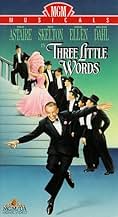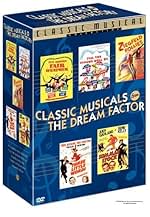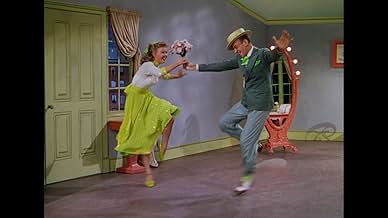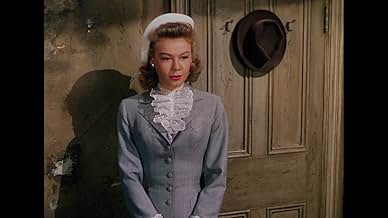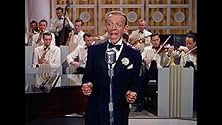IMDb RATING
6.9/10
2.2K
YOUR RATING
The story of the successful Tin Pan Alley songwriting team of Bert Kalmar and Harry Ruby is told loosely and lightheartedly.The story of the successful Tin Pan Alley songwriting team of Bert Kalmar and Harry Ruby is told loosely and lightheartedly.The story of the successful Tin Pan Alley songwriting team of Bert Kalmar and Harry Ruby is told loosely and lightheartedly.
- Nominated for 1 Oscar
- 3 wins & 3 nominations total
Gloria DeHaven
- Mrs. Carter De Haven
- (as Gloria De Haven)
Harry Mendoza
- The Great Mendoza
- (as The Great Mendoza)
Jean Adcock
- Woman
- (uncredited)
Richard Allan
- Chorus Boy
- (uncredited)
William Bailey
- Man in Audience
- (uncredited)
Harry Barris
- Pianist at Party
- (uncredited)
- Director
- Writer
- All cast & crew
- Production, box office & more at IMDbPro
Featured reviews
The first time I saw "Three Little Words" was when I was a teenager on vacation in Tulsa, Oklahoma. My Dad was not a fan of Red Skelton, but he endured the pain of it jut as he was subjected to watching Betty Hutton screaming with red-face in "Annie Get Your Gun", but as far as the movie "Three Little Words" goes, I loved it. Being a tap dancer myself, I could tune in quite well to a singing and dancing movie. This has to be considered one of Fred Astaires best movies he ever made. His dance numbers were created by Hermes Pan, thank God, because any film in which Astaire created his own dance sequences showed a very good reason why Astaire should let the others attempt this job. As a result, all the numbers are excellent, especially the dancing of he and Vera-Ellen in the "Thinking of You" number, and what about Gloria DeHaven? Here she is playing her own mother Mrs. Carter DeHaven. That must have been a thrill for her, and did she sing "Who's Sorry Now?" to perfection!
As far as this being Debbie Reynolds screen debut. Not so! Her film debut was in "The Daughter of Rosie O'Grady" filmed by Warner Brothers starring Gordon MacRae, Gene Nelson, and the best dancer Hollywood has ever had to offer - June Haver, but Haver's talent was always underestimated and not given the credit for being the fine performer that she was!
But, what can you say about "Three Little Words" except - sit back, get out the pop-corn and the soda's, relax and watch an excellent cast have a field day doing some of the finest singing, acting, dancing, that you will ever witness on the silver screen. It's just too bad that these old movies can't be seen on the large silver screen so that our younger generation can see what entertainment was, is, and always will be all about!
Don
As far as this being Debbie Reynolds screen debut. Not so! Her film debut was in "The Daughter of Rosie O'Grady" filmed by Warner Brothers starring Gordon MacRae, Gene Nelson, and the best dancer Hollywood has ever had to offer - June Haver, but Haver's talent was always underestimated and not given the credit for being the fine performer that she was!
But, what can you say about "Three Little Words" except - sit back, get out the pop-corn and the soda's, relax and watch an excellent cast have a field day doing some of the finest singing, acting, dancing, that you will ever witness on the silver screen. It's just too bad that these old movies can't be seen on the large silver screen so that our younger generation can see what entertainment was, is, and always will be all about!
Don
This was a wonderful, feel-good movie with tons of songs, many of them appealing. There also were some great dancing scenes, no surprise there since Fred Astaire is one of the stars. Astaire and Vera-Ellen paired up well for those numbers.
This is one of the few films, even in the musicals, in which all the characters were nice people. In other words, there were no villains, no nasty people, which is refreshing to see now and then. It is supposedly the true-life account of songwriters Bert Kalmar (Astaire) and Harry Ruby (Red Skelton). Ruby is good at writing tunes, but not with lyrics. Kalmar supplies the lyrics and dance. Skelton also shows he had a decent singing voice.
The only unhappy moments in the movie are the squabbles between the two leading men, but that's not overdone and sometimes it's humorous. Skelton's character is the nicer of the two.
The leading ladies are wholesome-looking beautiful women. Vera-Ellen is a Shirley Jones-type pretty blonde with a great dancer's body. She's enjoyable to watch. Arlene Dahl, who was stunning, is the other leading female but her role was minor, unfortunately.
The movie is a good mixture of song, dance, comedy and drama and is an underrated film in that it that doesn't get a lot of publicity. Astaire was quoted as saying this was his favorite film. I agree. It's my favorite of his, too.
This is one of the few films, even in the musicals, in which all the characters were nice people. In other words, there were no villains, no nasty people, which is refreshing to see now and then. It is supposedly the true-life account of songwriters Bert Kalmar (Astaire) and Harry Ruby (Red Skelton). Ruby is good at writing tunes, but not with lyrics. Kalmar supplies the lyrics and dance. Skelton also shows he had a decent singing voice.
The only unhappy moments in the movie are the squabbles between the two leading men, but that's not overdone and sometimes it's humorous. Skelton's character is the nicer of the two.
The leading ladies are wholesome-looking beautiful women. Vera-Ellen is a Shirley Jones-type pretty blonde with a great dancer's body. She's enjoyable to watch. Arlene Dahl, who was stunning, is the other leading female but her role was minor, unfortunately.
The movie is a good mixture of song, dance, comedy and drama and is an underrated film in that it that doesn't get a lot of publicity. Astaire was quoted as saying this was his favorite film. I agree. It's my favorite of his, too.
This film didn't try to do much more than bring us the songs. And that was good. It was wildly anachronistic -- the early number with Astaire and Vera Ella was danced to jazz that had to be some 15 or 20 years later than the date of the film, which at that point would be early 1920s, the age of the Turkey Trot, when bands were still coming out from their military origins. But the later sequence in the capacious ballroom of the ocean liner to "Thinking of You" was lovely. And the shot of the liner was the Normandie, wasn't it? Queen Mary was a four stacker. Vera Ella was a wonderfully acrobatic dancer. Al Schacht WAS a pitcher -- for 3 years (1919-21) for the Senators. The poster who said he was a catcher may have been thinking of Ray Schalk, a hall of fame catcher for the White Sox (including the 1919 nine, though not implicated in the throwing of the Series). And Barris, Rinker, and Bing sang with Paul Whiteman, not Duke Ellington. The MGM color in the 40s and 50s was magnificent -- and this film shows it off superbly. This one is a very enjoyable musical, one of the best of a period that produced some great ones.
This movie is an excellent representation of the talents of all four stars,Fred Astaire,Vera Ellen,Red Skelton, and Arlene Dahl. Astaire and Vera Ellen open the show with as good a dance routine that I have seen. "Where did you get that girl" is wonderful,bright,and energetic. Red Skelton always one of my favorite funny men is very good and Arlene Dahl is as pretty as any of them. It's a shame that these types of movies aren't made anymore, because they brought joy and happiness to both my wife and I and we watch the dance scenes over and over,especially Where did you get that girl. Vera Ellen was certainly as good as any of Astaires partners and in my opinion the best of all of them.
... because the whole thing goes down so easy.
It's an odd combination - Red Skelton and Fred Astaire. It was the only time that they ever played opposite one another. They were both in a couple of the big MGM ensemble musicals of the era - "Ziegfeld Follies" comes to mind - but they didn't do anything together in them. That's too bad, because their styles seem to bring out the best in each other as far as acting goes. Fred becomes more of a comic. Red becomes subdued.
This is the very fictionalized biopic of songwriting team Bert Kalmar (Fred Astaire) and Harry Ruby (Red Skelton). In the film, Kalmar is a dancer who is a part time playwright and magician. One night when Kalmar is performing his magic act, Ruby, a stagehand, manages to accidentally destroy everything single-handedly, causing Kalmar to get laughed off the stage. This is the "meet cute" phase. When Kalmar injures his knee and must lay off dancing for two years, he becomes a full-time songwriter and ends up reluctantly partnered with Ruby, who he still blames for ruining his act that one time. Of course, reluctance turns to friendship and great success. There are squabbles along the way and Kalmar and his wife (Vera Ellen of the tiny waistline) step in to discretely disrupt Ruby's bad romantic choices.
The squabbles are short lived and on the surface, for there really are no villains in this film, not even a buffoonish one like Singin' In the Rain's Lena Lamont. It's just the great balance of comedy, music, and heart that many of MGM's other musicals wanted to be but just could not quite accomplish. This one has aged very well, and I'd recommend it.
It's an odd combination - Red Skelton and Fred Astaire. It was the only time that they ever played opposite one another. They were both in a couple of the big MGM ensemble musicals of the era - "Ziegfeld Follies" comes to mind - but they didn't do anything together in them. That's too bad, because their styles seem to bring out the best in each other as far as acting goes. Fred becomes more of a comic. Red becomes subdued.
This is the very fictionalized biopic of songwriting team Bert Kalmar (Fred Astaire) and Harry Ruby (Red Skelton). In the film, Kalmar is a dancer who is a part time playwright and magician. One night when Kalmar is performing his magic act, Ruby, a stagehand, manages to accidentally destroy everything single-handedly, causing Kalmar to get laughed off the stage. This is the "meet cute" phase. When Kalmar injures his knee and must lay off dancing for two years, he becomes a full-time songwriter and ends up reluctantly partnered with Ruby, who he still blames for ruining his act that one time. Of course, reluctance turns to friendship and great success. There are squabbles along the way and Kalmar and his wife (Vera Ellen of the tiny waistline) step in to discretely disrupt Ruby's bad romantic choices.
The squabbles are short lived and on the surface, for there really are no villains in this film, not even a buffoonish one like Singin' In the Rain's Lena Lamont. It's just the great balance of comedy, music, and heart that many of MGM's other musicals wanted to be but just could not quite accomplish. This one has aged very well, and I'd recommend it.
Did you know
- TriviaBert Kalmar and Harry Ruby were friends of Fred Astaire from their early days together in vaudeville. Astaire said the film was one of his all-time favorites.
- GoofsThe stills of the The Marx Brothers (three rather than four) outside the opening of Animal Crackers (Broadway, 1928) is actually from Les Marx au grand magasin (1941).
- Quotes
Bert Kalmar: I wouldn't write that song with you if you begged me.
Harry Ruby: Begged ya? I didn't even ask ya.
Bert Kalmar: I guess you just can't help it, Harry. I feel sorry for you.
Harry Ruby: Feel sorry for me? You must think I'm just a...
Bert Kalmar: I could tell you what I think of you in just three little words. You're a dope!
- Crazy creditsThe opening and end titles use various first pages of Kalmar-Ruby sheet music as backgrounds.
- ConnectionsFeatured in Metro-Goldwyn-Mayer's World Famous Musical Hits! (1962)
- SoundtracksWhere Did You Get That Girl?
(uncredited)
Written Harry Puck, Bert Kalmar
Sung and Danced by Fred Astaire, Vera-Ellen (dubbed by Anita Ellis)
- How long is Three Little Words?Powered by Alexa
Details
Box office
- Budget
- $1,470,000 (estimated)
- Runtime1 hour 42 minutes
- Color
- Aspect ratio
- 1.37 : 1
Contribute to this page
Suggest an edit or add missing content




